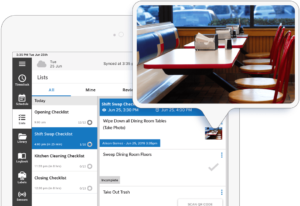Last year’s report from QSR Magazine dropped a statistical bomb on the fast food industry.
Chick-fil-A makes nearly twice as much per location as its closest competitor (McDonald’s).
Beating out the big arches is particularly remarkable for a business that’s closed on Sundays.
Considering most McDonald’s are open 24 hours, Chick-fil-A is achieving nearly twice the revenue with less than half the hours.
So what’s Chick-fil-A doing that keeps it head and shoulders above McDonald’s, Starbucks, and Subway in revenue per store?
Two words:
Customer experience.
Below, we break down just how Chick-fil-A wins the customer experience battle for the quick service restaurant industry, and how they’re using digital operations to drive accountability and consistency in their stores.
Chick-fil-A Leads in Revenue Per Location
For billion dollar brands like Chick-fil-A, consistency is the foundation on which you scale the business.
Chick-fil-A corporate is hyper-focused on creating successful, individual locations, and so far, they’ve done it with great success.
According to a study by Nation’s Restaurant News, “[Chick-fil-A] has been growing at an impressive speed… with 16.7% sales growth in 2018, pushing it past the $10 billion mark in annual domestic sales.”
At roughly 2,400 stores across America, the average Chick-fil-A store made 4.1 million last year.
How has Chick-fil-A been able to spread that success across all their stores?
To start, Chick-fil-A franchisees cannot own more than two locations. That means they’re forced to make those two stores as profitable as possible.
If a franchise owner has two stores, each pulling in 2.5 million, he cannot open two more to reach his 10 million goal.
That owner has to optimize his current stores to achieve twice as much.
That’s where consistency and accountability come in.
Chick-fil-A Trains Employees for Consistency
With a focus on the customer, Chick-fil-A trains employees to deliver exactly the same service at every location.
How do they manage this sort of consistency with more than 2,000 stores?
Chick-fil-A has adopted digital restaurant operations, meaning they’ve stopped running stores on paper and equipped employees with tablets for training, checklists, labeling, and more.
Training is especially important at Chick-fil-A, where order accuracy is a top concern.
Using the iPad in each store, employees are quizzed on brand standards and menu items inside Jolt.
You only have to ask how many pickles go on a sandwich a few times before every staff member knows it’s two.
Many Chick-fil-A stores use Jolt to train every staff member on how to complete labeling and prep, too.
By adopting digital training with Jolt, Chick-fil-A is able to deliver accurate orders 94.5% of the time — a near perfect score.
Digital Checklists Improve Employee Accountability
Most restaurants that use paper checklist to run their daily operations struggle with employee accountability.
For Chick-fil-A, digital checklists are the foundation of accountability, as they go beyond the checkmark to give you detailed, real-time information about every store.
Most Chick-fil-A’s across America use Jolt digital checklists to improve employee accountability and get more done in their stores.
Want to see that store #2 has stocked the condiments before the lunch rush?
Just require them to use photo-proof in their morning checklist.
Once these habits are built, teams get faster and faster at knowing the proper way to accomplish their repeated tasks, and efficiency improves.
An example of photo-proof inside a Jolt checklist.

Digital checklists also help employees feel accountable for the work they’re accomplishing. With digital checklists, managers can easily see who’s doing what, and exactly what time they did it.
Moving from paper to digital operations has paid off for Chick-fil-A, whose employees set the standard for accountability in the QSR industry.
Where other brands still worry about pencil whipping, Chick-fil-A franchisees have chosen to eliminate it entirely by switching from paper to digital checklists.
Digital Food Safety Ensures A Consistent Customer Experience
Chick-fil-A has been ahead of the game for years when it comes to digitizing back of house operations.
Many Chick-fil-A stores have used digital food and date labeling since 2017, when Jolt released custom labeling as an option.
Digital food labeling removes human error in calculating expiration dates. Beyond that, it’s exponentially faster than the industry standard (which is writing on day dots with a Sharpie).
Jolt connects an inkless printer to your store’s tablet or iPad, and employees simply touch-to-print labels with auto-calculated dates and information.
Chick-fil-A does a similar thing with temperature logs.
By connecting a digital temperature probe directly to their tablet with Jolt, there’s no chance for falsification of temperatures.
Employees can simply probe a chicken fillet, and the digital probe will automatically stabilize and record it in Jolt.
If that temperature is outside the appropriate range, Jolt displays an error on the screen and prompts corrective action.
By automating these previously manual processes, Chick-fil-A is able to be consistent in the way they serve food at every location.
Digital food safety is a serious advantage for Chick-fil-A’s back of house operations, and the proof is in their revenue.
Chick-fil-A Is All-In on Digital Restaurant Operations
By using digital automation to remove human error from many of Chick-fil-A’s daily, repeatable processes, the chicken chain has been able to beat out even the most established brands in the QSR industry when it comes to revenue.
If you’re curious about digital restaurant operations for your stores, reach out to us here, and we’ll give you a free personalized demo of Jolt software.
To learn more about moving from paper to digital operations, check out this blog: Why Top Brands Are Switching from Paper to Digital Checklists for Accountability
